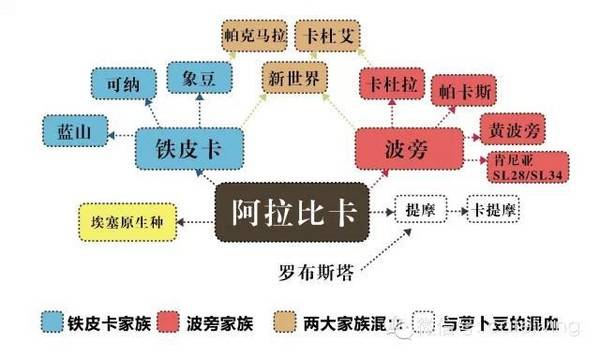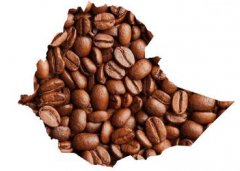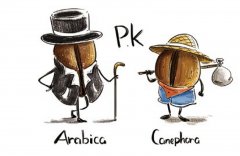How many kinds of Arabica coffee beans are there?

Professional coffee knowledge exchange more coffee bean information please follow the coffee workshop (Wechat official account cafe_style)
They are also members of Arabica, why are some coffee beans so expensive?
It has always been a complicated matter to classify coffee genetically. As far as the coffee varieties on the market are concerned, the most superficial classification is of course divided into Arabica and Robusta (hereinafter referred to as radish beans). The difference between Arabica and radish beans can be understood by following Wechat cafeliving's reply to fish balls, and the editor will not repeat them here. Today we are mainly going to talk about the lineage division of the members of the Arabica family.
OK, now let's talk to the members of the Arabica family-but only some of the key members are introduced here, not all of them!
The elders of the two families
Iron pickup
"Typica" iron pickup, the name sounds majestic, but in fact it is not so strong. It has weak physique, poor disease resistance, easy to catch rust leaf disease and less fruit yield. It is one of the oldest native varieties in Ethiopia, and many Arabica are derived from iron pickups!
The parietal leaf of the iron pickup is bronzed, and the bean grain is large, pointed, oval or thin. Everyone is familiar with the well-known Mantenin, Blue Mountain, Elephant Bean, Kona, Yunnan Dou …... Wait. They are all derived from iron pickups. (how bad it is)
Bourbon
"Bourbon" bourbon is an ancient and excellent variety juxtaposed with iron pickup, and some botanists believe that bourbon is an early variety of iron pickup after it was transplanted to Yemen.
Bourbon is almost all round beans, beans are a little smaller than tin card, ripening later, but the yield is 30% more than tin card. It is suitable for growing above 1200 meters above sea level, and its flavor is obviously more prominent than those below 1000 meters, but bourbon has a disadvantage that it will rest for a year as a result. Round bourbon is full of vitality, and its resistance to rust leaf disease is better than that of iron pickup, but its flavor is as good as it, or even better.
In 1810, some of the round beans in Bourbon Island mutated into pointed beans, which is known as the "pointed bourbon". It is characterized by a caffeine content of only half, low output, weak physique, and extremely rare, just like a weak aristocratic teenager.
In addition, the biggest thing that iron pickup and bourbon have in common is that they both need the protection of shade trees. if there is no shade tree to help it block the sun, it is not only not conducive to its growth, but also greatly reduces the flavor of coffee beans.
Gene mutant
The variants of the Bourbon family
Kenya
"SL28" and "SL24" is a bourbon line screened and cultivated by French and British missionaries and researchers in Kenya at the beginning of the 20th century. For a hundred years, it has adapted to the high concentration of phosphate soil in Kenya, and the Kenyan bean has a special sour aura, which is different from the bourbon bean in Central and South America. However, after it was transplanted to Asia, it lost its flavor and could not show their characteristics.
Yellow bourbon
"Bourbon Amarello" yellow bourbon is a unique yellow-skinned bourbon variety in the Brazilian state of Sao Paulo. Coffee fruits usually turn red when ripe, but yellow bourbon does not turn red when ripe, so it is named after orange. Huang Boban became Deep-Fried Chicken of the boutique coffee industry because he almost won the top three prizes in "CoE" (Chinese name: extraordinary Cup).
Kaddura
"Caturra" is a single gene variant of bourbon discovered in Brazil in the 1950s. It has better yield and disease resistance than bourbon, and the tree is shorter and easy to harvest. Unfortunately, it has the same problem as bourbon-- as a result, it has a year off, and the flavor is equal to or slightly worse than bourbon beans.
But it is more adaptable, can be planted with high density, does not need shade trees, and can be vibrant in direct exposure to the sun, so it is also called "exposed coffee" (Sun Coffee).
Kaddura is suitable for high altitude areas from 700m to 1700 m, but the higher the altitude is, the better the flavor is, and the bean yield is relatively reduced. There are also variants of yellow Kaddura in Central and South America, but the wind rating is not as good as Huang bourbon.
Pacas
"Pacas" in 1935, El Salvador coffee farmer "Don Alberto Pacas" selected high-production San Ramon bourbon varieties and moved them to the farm for planting. In 1956, his coffee tree produced more fruit than the same kind of coffee trees. University of Florida professor "Dr. William Cogwill" identified this as a genetic mutation in bourbon and named it "Pacas".
Pacas, with its high output and good quality, is popular in Central America. Currently, 68% of El Salvador is bourbon, while Pacas has 29%.
The variants of the iron pickup family.
Elephant bean
"Maragogype" was discovered in 1870 in the "Maragogype" producing area of "Bahia" in northeastern Brazil. It got its name because the bean body is at least three times larger than the average Arabica, making it the largest in the world. It is the most well-known variety of iron pickup beans, is the giant baby of the iron pickup family.
Elephant beans are very suitable for the low altitude area of 700-800 meters, but the flavor is dull, tasteless, and even has a fishy smell. Therefore, it is appropriate to choose the area above 1000 meters above sea level, with better flavor, mild sour taste and sweet fragrance.
Can accept
Although "Kona" is planted at an altitude of several hundred meters, it comes from Kona, a big island of Hawaii, with a mild sea breeze and fertile volcanic soil, with an incomparably clean acidity and sweetness. Compared with the blue mountains with higher elevations, it is even worse.
Blue Mountain
"BlueMountain" is popular all over the world, and Blue Mountain, which is hard to get a bean, comes from the iron pickup family. Why is Blue Mountain so hot and expensive?! It is mostly because it is contracted by the royal army, and partly because it is not satisfied with soil and water and is in poor condition once it leaves Jamaica. After two hundred years of domestication, Blue Mountain has evolved successfully in Jamaica, and its resistance to fruit rot is better than that of ordinary iron pickups. Where can the Blue Mountains be tamed next? We can look forward to it.
A hybrid of two families.
New World
"Mundo novo" bourbon had an affair with the iron pickup! There are illegitimate children in two families! It was first found in Brazil with high yield and strong disease resistance. The only drawback is that it can be more than 3 meters high and is not easy to harvest. Because of the good quality of cup test, it is regarded as the new hope of Brazilian coffee industry, so it is named New World.
Kaduai
"Catuai" Kaduai is a hybrid of New World and Kaddura. It inherits the advantage of Kaddura's low stature and makes up for the weakness of Arabica fruit. The result is solid, and it is not easy to fall when the strong wind blows. The biggest regret is that its overall flavor is slightly more monotonous than Kadura.
Kaduai also has the difference between red fruit and yellow fruit, and red fruit wins more often than yellow fruit. Kaduai, Kaddura, New World and bourbon are the four main varieties of coffee in Brazil.
Pacamara
The "Pacamara" Pacamara is the crystallization of the elephant bean of the iron pickup and the Pacas of the bourbon. It is also a hybrid, and the size of the bean is second only to the elephant bean. In 2007, he won the "CoE" championship of Guatemala and Honduras, and even arranged the top three awards of El Salvador, which is a rising star of El Salvador.
Bastards with turnips
Timo
"Timor" found the baby of Arabica and radish beans in East Timor, an island country at the eastern end of the Nusa Tenggara Islands. Timo, closer to Arabica. Timo has a low sour taste and lacks characteristics, so it is commonly used in Taiwan to make low-cost formula beans. Well, in terms of the importance of genes.
However, East Timor also has high-altitude pure Tibica treated with water. Before buying, it is important to find out whether it is a hybrid or a purebred iron card water washed beans, the quality of the two is very different, the former is mediocre, and the latter is amazing.
Katimo
"Catimor" in 1959, the Portuguese moved the bourbon variety Kaddura to East Timor and mixed it with Timo with radish bean pedigree to produce a second generation of mixed Katimo with strong disease resistance and yield.
Although Katimo inherits the strong advantages of radish beans, it also inherits genes with poor flavor. In recent years, botanists from all over the world have turned to the interbreeding of Arabica and Katimodo belts in an attempt to reduce the pedigree of radish beans in order to improve the bad reviews of the Katimo Cup.
Ikatu
"Icatu" in the past, Alabaster "Arabusta" mixed with Arabica and radish beans increased yield and disease resistance, but the flavor of coffee was not good all the time. Scientists crossed Arabica varieties with Arabica varieties such as Kaddura, New World and Bourbon for many generations, which gradually reduced the bad smell of radish beans and improved the aroma of Arabica beans, thus giving birth to an excellent variety of multi-generation hybrids-Icato.
In addition, the hybrids of Arabica and radish beans, such as "Ruiru 11", "Chandragiri" and so on, generally inherit the stout disease resistance of radish beans, but weaken the flavor of Arabica. For coffee lovers, whether these hybrids can perform satisfactorily or not remains to be further cultivated and tested.
The purpose of this paper is to give coffee newcomers a concise understanding of Arabica variety classification, which can not be used as a reference for rigorous botanical classification.
.
Important Notice :
前街咖啡 FrontStreet Coffee has moved to new addredd:
FrontStreet Coffee Address: 315,Donghua East Road,GuangZhou
Tel:020 38364473
- Prev

Hometown of Arabica Coffee beans-introduction to the description of the characteristics, flavor and taste of Ethiopian coffee varieties
Professional coffee knowledge exchange more coffee bean information Please note that the coffee workshop (Wechat official account cafe_style) is also a member of Arabica, why are some coffee beans so expensive? This article will introduce: national Geographic and Coffee planting History and Coffee Bean characteristics National Geographic and
- Next

What does the difference between Arabica and Robusta mean by Arabica coffee beans in KFC?
Professional coffee knowledge exchange more coffee bean information Please note that the coffee workshop (Wechat official account cafe_style) is also a member of Arabica, why are some coffee beans so expensive? In many places where coffee is sold, it is not difficult to find words like 100% Arabica, and even canned coffee has a style called XX Arabica coffee, which makes people curious.
Related
- Detailed explanation of Jadeite planting Land in Panamanian Jadeite Manor introduction to the grading system of Jadeite competitive bidding, Red bid, Green bid and Rose Summer
- Story of Coffee planting in Brenka region of Costa Rica Stonehenge Manor anaerobic heavy honey treatment of flavor mouth
- What's on the barrel of Blue Mountain Coffee beans?
- Can American coffee also pull flowers? How to use hot American style to pull out a good-looking pattern?
- Can you make a cold extract with coffee beans? What is the right proportion for cold-extracted coffee formula?
- Indonesian PWN Gold Mandrine Coffee Origin Features Flavor How to Chong? Mandolin coffee is American.
- A brief introduction to the flavor characteristics of Brazilian yellow bourbon coffee beans
- What is the effect of different water quality on the flavor of cold-extracted coffee? What kind of water is best for brewing coffee?
- Why do you think of Rose Summer whenever you mention Panamanian coffee?
- Introduction to the characteristics of authentic blue mountain coffee bean producing areas? What is the CIB Coffee Authority in Jamaica?

